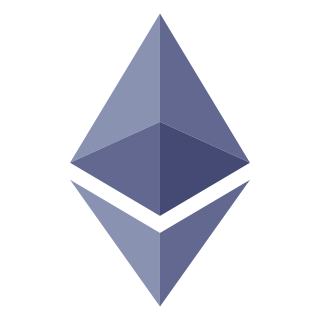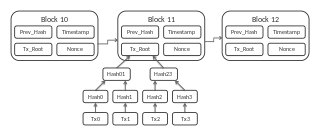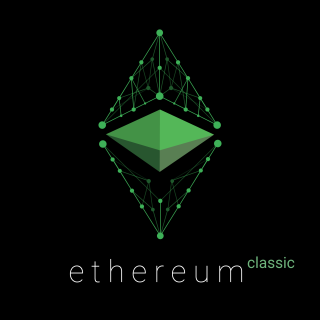
In cryptography, a nonce is an arbitrary number that can be used just once in a cryptographic communication. It is similar in spirit to a nonce word, hence the name. It is often a random or pseudo-random number issued in an authentication protocol to ensure that old communications cannot be reused in replay attacks. They can also be useful as initialization vectors and in cryptographic hash functions.
Trusted timestamping is the process of securely keeping track of the creation and modification time of a document. Security here means that no one—not even the owner of the document—should be able to change it once it has been recorded provided that the timestamper's integrity is never compromised.
Bitcoin (₿) is a cryptocurrency. It is a decentralized digital currency without a central bank or single administrator that can be sent from user to user on the peer-to-peer bitcoin network without the need for intermediaries.
Namecoin is a cryptocurrency originally forked from bitcoin software. It is based on the code of bitcoin and uses the same proof-of-work algorithm. Like bitcoin, it is limited to 21 million coins.
In cryptography, scrypt is a password-based key derivation function created by Colin Percival, originally for the Tarsnap online backup service. The algorithm was specifically designed to make it costly to perform large-scale custom hardware attacks by requiring large amounts of memory. In 2016, the scrypt algorithm was published by IETF as RFC 7914. A simplified version of scrypt is used as a proof-of-work scheme by a number of cryptocurrencies, first implemented by an anonymous programmer called ArtForz in Tenebrix and followed by Fairbrix and Litecoin soon after.

A cryptocurrency is a digital asset designed to work as a medium of exchange wherein individual coin ownership records are stored in a digital ledger or computerized database using strong cryptography to secure transaction record entries, to control the creation of additional digital coin records, and to verify the transfer of coin ownership. It typically does not exist in physical form and is typically not issued by a central authority. Some cryptocurrencies use decentralized control as opposed to centralized digital currency and central banking systems. When a cryptocurrency is minted or created prior to issuance or held on a centralized exchange, it is generally considered centralized. When implemented with decentralized control, each cryptocurrency works through distributed ledger technology, typically a blockchain, that serves as a public financial transaction database.

The bitcoin network is a peer-to-peer payment network that operates on a cryptographic protocol. Users send and receive bitcoins, the units of currency, by broadcasting digitally signed messages to the network using bitcoin cryptocurrency wallet software. Transactions are recorded into a distributed, replicated public database known as the blockchain, with consensus achieved by a proof-of-work system called mining. Satoshi Nakamoto, the designer of bitcoin, claimed that design and coding of bitcoin began in 2007. The project was released in 2009 as open source software.

Primecoin is a cryptocurrency that implements a proof-of-work system that searches for chains of prime numbers.

Ethereum is an open source, public, blockchain-based distributed computing platform and operating system featuring smart contract (scripting) functionality. It supports a modified version of Nakamoto consensus via transaction-based state transitions.

Bitcoin Core is free and open-source software that serves as a bitcoin node and provides a bitcoin wallet which fully verifies payments. It is considered to be bitcoin's reference implementation. Initially, the software was published by Satoshi Nakamoto under the name "Bitcoin", and later renamed to "Bitcoin Core" to distinguish it from the network. For this reason, it is also known as the Satoshi client.

A blockchain, originally block chain, is a growing list of records, called blocks, that are linked using cryptography. Each block contains a cryptographic hash of the previous block, a timestamp, and transaction data.
Monero is an open-source cryptocurrency created in April 2014 that focuses on fungibility, privacy and decentralization. Monero uses an obfuscated public ledger, meaning anybody can broadcast or send transactions, but no outside observer can tell the source, amount or destination. Monero uses a Proof of Work mechanism to issue new coins and incentivize miners to secure the network and validate transactions.

Ethereum Classic is an open source, blockchain-based distributed computing platform featuring smart contract (scripting) functionality. It supports a modified version of Nakamoto consensus via transaction-based state transitions executed on a public Ethereum Virtual Machine (EVM).
Dragonchain is a blockchain platform for enterprises. It was originally developed at The Walt Disney Company in Seattle in 2014 and then open-sourced in 2016. Despite extensive speculation, there is absolutely no relationship between Disney and Dragonchain. The open source code is maintained by the Dragonchain Foundation. And the commercial blockchain platform is maintained by the commercial entity named Dragonchain, Inc. Dragonchain is a public/private hybrid blockchain platform. Developers can use existing smart contracts from the library or write their own smart contracts and build (decentralized) blockchain applications in known languages.

The Lightning Network is a "Layer 2" payment protocol that operates on top of a blockchain-based cryptocurrency. It enables fast transactions among participating nodes and has been touted as a solution to the Bitcoin scalability problem. It features a peer-to-peer system for making micropayments of cryptocurrency through a network of bidirectional payment channels without delegating custody of funds. Lightning Network implementation also simplifies atomic swaps.

The bitcoin scalability problem is the limited rate at which the bitcoin network can process transactions. It is related to the fact that records in the bitcoin blockchain are limited in size and frequency.
Ethash is the proof-of-work function in Ethereum-based blockchain currencies. It uses Keccak, a hash function eventually standardized to SHA-3. These two are different, and should not be confused. Since version 1.0, Ethash has been designed to be ASIC-resistant via memory-hardness and easily verifiable. It also uses a slightly modified version of earlier Dagger and Hashimoto hashes to remove computational overhead. Previously referred to as Dagger-Hashimoto, the Ethash function has evolved over time. Ethash uses an initial 1 GB dataset known as the Ethash DAG and a 16 MB cache for light clients to hold. These are regenerated every 30,000 blocks, known as an epoch. Miners grab slices of the DAG to generate mix-hashes using transaction and receipt data, along with a cryptographic nonce to generate a hash below a dynamic target difficulty.

OpenTimestamps (OTS) is an open-source project that aims to provide a standard format for blockchain timestamping. With the advent of systems like Bitcoin, it is possible to create and verify proofs of existence of documents (timestamps) without relying on a trusted third party; this represents an enhancement in term of security, since it excludes the possibility of a malicious notary to compromise the timestamp.
A blockchain is a shared database that records transactions between two parties in an immutable ledger. Blockchains document and confirm pseudonymous ownership of all existing coins within a cryptocurrency ecosystem at any given time through cryptography. After a transaction is validated and cryptographically verified by other participants or nodes in the network, it is made into a "block" on the blockchain. A block contains information about the time the transaction occurred, previous transactions, and details about the transaction. Once recorded as a block, transactions are ordered chronologically and cannot be altered. This technology rose to popularity after the creation of Bitcoin, the first application of blockchain technology, which has since catalyzed other cryptocurrencies and applications.









